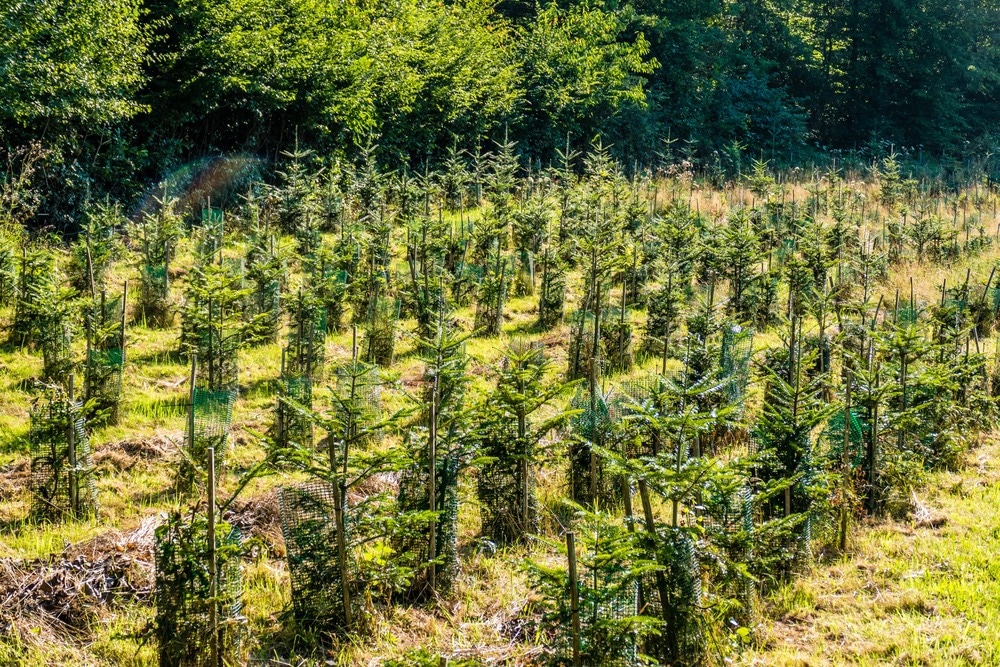Forests are an important ecosystem on our planet, but they are disappearing at an alarming rate. They are home to rich biodiversity and act as a natural carbon sink, which helps counteract global warming; however, forests are being cut down to make way for agricultural land and accommodate accelerating urbanization.

Regenerative forestry. Image Credit: Dietrich Leppert/Shutterstock.com
This is threatening the world’s biodiversity as well as exacerbating global warming. To address this problem, regenerative forestry is underway to reestablish our global forests. Here, we discuss the importance of maintaining our forests, and how regenerative forestry is helping us to do this.
Why Should we Protect our Forests?
Forests currently occupy a little under one-third (31%) of the land on our planet and accommodate over three-quarters of terrestrial life on it. They are vitally important to sustaining life on Earth. Our forests purify the air and water; for example, just one mature tree can absorb over 48 pounds of carbon dioxide from the atmosphere each year, releasing oxygen in exchange. This means that our forests are important for mitigating climate change by soaking up the carbon dioxide that is being released into our atmosphere.
Forests also provide a reliable source of work for more than 13.2 million people, and they provide a further 41 million people jobs in related sectors.
While forests are incredibly important to life on Earth, we are losing them at a concerning rate. Between 2001 and 2021, the Earth lost 437 Mha of tree cover, equating to an 11% decrease. Losing just 11 % of our trees means that the Earth’s capacity to absorb carbon has decreased by at least 176 Gt. Deforestation is probably the greatest threat to our forests. The Amazon alone has lost 17 % of its tree cover in the last five decades, which was mostly caused by deforestation to clear space for cattle ranches. As the world’s population increases, this problem will likely only get worse.
The planet is facing increasing challenges due to the changing climate and biodiversity loss. Given that 25% of our medicines have been derived from rainforest plants, we need to protect biodiversity not only to protect ecosystems but to maintain an important source for the development of novel therapeutics.
To protect our forests, people from a number of organizations and agencies have come together to influence the management of forests so that the climate, nature, and humankind, can continue benefiting from it.
Regenerative forestry has emerged as an important strategy for maintaining our forests. It aims to promote resilient and adaptive forests, restore lost biodiversity, and produce timber and other products that will help mitigate climate change and provide an essential source of jobs.

Regenerative forestry. Image Credit: Dietrich Leppert/Shutterstock.com
How does Regenerative Forestry Work?
Regenerative forestry can look different depending on the scale and location of the project. For example, a regenerative forestry project in the UK may use different tactics than one in a tropical climate. However, they mostly include multiple tactics, including but not limited to: planting more trees, increasing biodiversity, protecting forest soils, creating productive forests that supply timber and capture carbon dioxide, and integrating trees and forests into farming.
The concept of regenerative forestry should not be considered a stand-alone methodology. It should be viewed as part of the wider restoration culture that requires a collaborative approach, drawing together academics, scientists, communities, local governments and councils, and businesses.
Priorities for regenerative forestry include the restoration of damaged habitats, the establishment of sustainable production practices, the abandonment of damaging practices, and the promotion of widespread ecological regeneration.
Regenerative forestry also follows a number of principles that allow individual forests to be managed appropriately. Firstly, regenerative forestry is taken on as a whole system approach, where benefits for the climate, nature, and population are achieved via affecting lasting change both within the first and forest ecosystem services outside the forest.
Second, regenerative forestry is delivered as an integrated approach, where the appropriate agencies are drawn in to ensure that newly regenerated forests are diverse, resilient, and integrated into the wider agricultural landscape.
Next, regenerative forestry is focused on establishing forests that can take care of themselves. In that way, climate change, nature, and people can be positively impacted in the long term.
Fourth, regenerative forestry incorporates improved forest management practices that aim to deliver optimal outcomes over the entire forest environment, not just in isolated areas. The entire forest must work to benefit climate change, rather than just sections that have been replanted. Finally, regenerative forestry should support high levels of engagement. People must be drawn in to interact with the forest to establish lasting relationships that are beneficial for both sides. The forest should provide job opportunities for people either directly or indirectly.
Overall, regenerative forestry sets out to mitigate climate change in the long term while establishing self-sufficient forests that boost biodiversity and support humans in a sustainable manner.
Further Reading
Last Updated: Oct 5, 2022